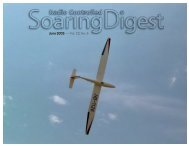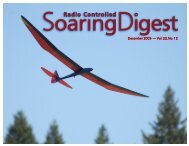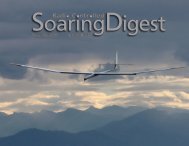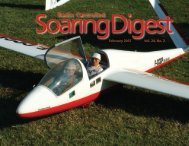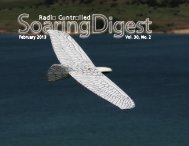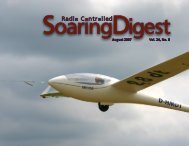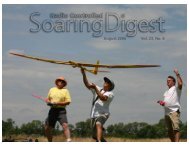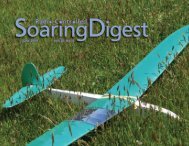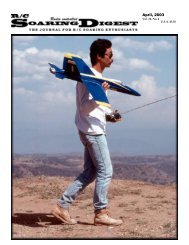October, 2002 - RC Soaring Digest - RCSoaring.com
October, 2002 - RC Soaring Digest - RCSoaring.com
October, 2002 - RC Soaring Digest - RCSoaring.com
You also want an ePaper? Increase the reach of your titles
YUMPU automatically turns print PDFs into web optimized ePapers that Google loves.
for another thermal. In good weather,<br />
too many pilots catch their lift, often<br />
joined by others, then off they fly miles<br />
downwind to enormous heights,<br />
patiently waiting for the two-minute<br />
signal.<br />
Big snag with my first idea was<br />
identifying 12 models as they crossed<br />
the sightlines.<br />
Somebody has had inspiration, and it<br />
is simple. Bob Owston has flown F3J<br />
since its earliest days and <strong>com</strong>bines his<br />
hobby with earning a living as an<br />
engineer and an architect, a sure sign<br />
of ability to think laterally.<br />
His brilliant idea is to use the launch<br />
line to define a plane across the skies.<br />
Each launch spot would have a circular<br />
hoop (as used by individuals in F3B<br />
and F5B) sighting along the line. Each<br />
flyer would be required to cross the<br />
launch plane and circle through at<br />
least 360 degrees between a three<br />
minute hooter and a four minute<br />
hooter say, and then the same again<br />
between seven and eight minutes.<br />
The spotter for each pilot would be<br />
required to raise a flag as his pilot was<br />
<strong>com</strong>pleting the circle. Independent<br />
checking of the turning circles would<br />
not be needed during a run-of-the-mill<br />
<strong>com</strong>petition, except perhaps on a<br />
random basis. An important championships<br />
it could be. For each of the two<br />
<strong>com</strong>pleted circles over the launch line,<br />
the pilot would score 150 points say, a<br />
value rather more than a spot landing.<br />
Why is 150 points chosen? Sharp guys<br />
will quickly recognise that a maximum<br />
score would then be<strong>com</strong>e 10 X 60<br />
duration plus 100 landing plus 150 X 2<br />
circles equals 1,000 points. This would<br />
allow a far easier guess at normalised<br />
scores when seconds are lost to a rival.<br />
In good weather, the two circle tasks<br />
would merely add a little zest to each<br />
flight. Typically it could force flyers to<br />
find a second and third patch of lift. In<br />
scratchy conditions, the pilot would<br />
face the choice of staying in good lift<br />
and forget the circle bonus points. If<br />
the two baseline circle risks are taken,<br />
the pilot might fail to find lift and be<br />
forced to land before the end of the<br />
slot.<br />
Another big bonus to this “new-look<br />
F3J” is that the models returning to the<br />
<strong>October</strong> <strong>2002</strong><br />
start line would be<strong>com</strong>e “spectatorfriendly”<br />
and visible. Flying an efficient<br />
path back to the line, turning<br />
through a circle and then setting off<br />
again upwind or downwind to regain<br />
height would make our <strong>com</strong>petitions<br />
more exciting to watch. (My wife<br />
reckons: F3J flying is only slightly<br />
more interesting than watching paint<br />
dry.) Our sport might be<strong>com</strong>e more<br />
attractive!<br />
Any more ideas, or any better ideas?<br />
How about someone putting these<br />
ideas into a set of rules for Tomas<br />
Bartovksy and Sandy Pimenoff to<br />
chew over, and someone to organise a<br />
trial <strong>com</strong>p!<br />
First months of <strong>2002</strong> brought lousy<br />
weather in UK, which spoilt practice<br />
days and forced abandonment of the<br />
first league event. But by the end of<br />
<strong>October</strong>, we’d had seven valid events,<br />
with the best four counting towards<br />
the three UK team places for next year.<br />
Four or five contests were held in<br />
enjoyable weather rather than the<br />
usual dodging between showers and<br />
gusts of high wind.<br />
One of the nicest Finns to meet in<br />
Lappeenranta was Tommy Westlin,<br />
assistant contest director in the trannie<br />
impound, who started the slots and the<br />
timing device. He ordered a Sharon<br />
Pro 3.7 after the contest, having been<br />
impressed by Tobias Lammlein and<br />
several others with this model during<br />
the champs. He wrote asking for my<br />
settings.<br />
With job pressure, he expects to have<br />
his Sharon ready for testing after<br />
Christmas. Initial flights will be on a<br />
nearby frozen lake with a blanket of<br />
snow on top. And we <strong>com</strong>plain about<br />
British weather.<br />
Feedback from all over the globe<br />
shows that most countries do not enjoy<br />
more than one annual F3J <strong>com</strong>petition<br />
and that is how they select national<br />
teams. In several countries F3J flyers<br />
are so few that they can’t cope with<br />
two-man tows if they want six or more<br />
in any slot. So they use winches.<br />
Perhaps we in the UK don’t have it so<br />
bad after all!<br />
Let me tell what excites me most in<br />
model soaring’s future at this time. I<br />
have be<strong>com</strong>e hooked by hlg, particularly<br />
since the advent of SAL – side<br />
arm launching – which thank goodness<br />
is now settling down to the name<br />
of “discus” launching.<br />
Two years ago I wrote about it, courtesy<br />
of US and German articles. This<br />
year at Dortmund I bought my first<br />
model, the SAGA produced by<br />
Vladimir Gavrilko in the Ukraine. It<br />
flies like a French mistress or a Citroen<br />
car – as touchy as hell to keep going,<br />
but when it does, then out of this<br />
world.<br />
At the end of a late summer holiday in<br />
France, Austria and Germany, I<br />
traveled past Kirchheim am Teck,<br />
famous as home town of Graupner. A<br />
few people know that it is also close to<br />
where Claus Schnarrenberger lives,<br />
designer and producer of Murphy.<br />
This hlg with moulded two-servo<br />
wing, flown by his mate Ralph<br />
Mittelbach, has won the F3K Eurotour<br />
in 2000 and 2001. Claus has also won<br />
many F3K contests.<br />
I collected my new model and we<br />
enjoyed a couple of hours flying his<br />
Murphy and my Saga at the back of his<br />
house. He had 12 flights. Apart from<br />
the first, which he said was for trimming,<br />
he caught thermals small and<br />
large each time, bringing Murphy<br />
down at two or three minutes as<br />
declared before each launch. My Saga<br />
hit lift most times too, but I got away<br />
only three times out of 12. Murphy is<br />
magic! (How <strong>com</strong>e Herr<br />
Schnarrenberger calls his model<br />
Murphy? He tells that everything that<br />
could go wrong during its development<br />
and kitting did, so only one name<br />
was possible.)<br />
F3K, the hlg class, is sure to reach full<br />
FAI recognition soon. In fact Lausanne<br />
is pressing Eurotour and hlg supporters<br />
to make proposals for regional and<br />
world championships, fix the rules and<br />
get on with it. In contrast to the F3J<br />
supporters in the early 1990s, the F3K<br />
advocates want to proceed slowly.<br />
What they favour, says Alex<br />
Wunschheim who is current manager<br />
of F3K Eurotour, is to run a two-day<br />
trial event in conjunction with an F3J<br />
world champs.<br />
I’d cheer that super idea, for that<br />
means Calgary! Having the whole<br />
CIAM/FAI circus already assembled<br />
in Canada with top flyers from all over<br />
the world, you would certainly get a<br />
Page 17




